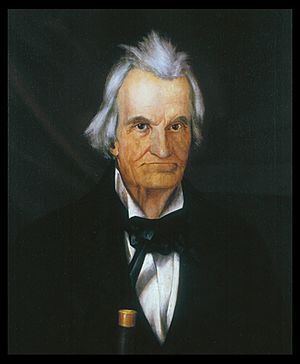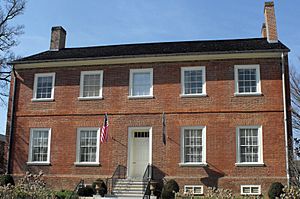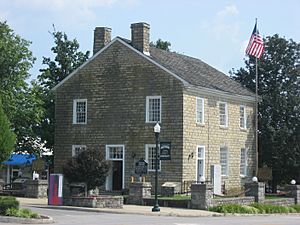Thomas Metcalfe (Kentucky politician) facts for kids
Quick facts for kids
Thomas Metcalfe
|
|
|---|---|
 |
|
| 10th Governor of Kentucky | |
| In office August 26, 1828 – September 4, 1832 |
|
| Lieutenant | John Breathitt |
| Preceded by | Joseph Desha |
| Succeeded by | John Breathitt |
| Member of the U. S. House of Representatives from Kentucky's 2nd district and 4th district | |
| In office March 4, 1819 – June 1, 1828 |
|
| Preceded by | Joseph Desha Samuel H. Woodson |
| Succeeded by | Robert P. Letcher John Chambers |
| United States Senator from Kentucky |
|
| In office June 23, 1848 – March 3, 1849 |
|
| Preceded by | John J. Crittenden |
| Succeeded by | Henry Clay |
| Member of the Kentucky House of Representatives | |
| In office 1812–1816 |
|
| Personal details | |
| Born | March 20, 1780 Fauquier County, Virginia |
| Died | August 18, 1855 (aged 75) Nicholas County, Kentucky |
| Political party | National Republican Whig |
| Spouse | Nancy Mason |
| Profession | Soldier, Stonemason |
| Signature | |
| Military service | |
| Branch/service | Kentucky militia |
| Rank | Captain |
| Battles/wars | War of 1812 |
Thomas Metcalfe (March 20, 1780 – August 18, 1855) was an important American politician. He was also known as "Stonehammer" because of his early job. He served as a U.S. Representative and a Senator. He also became the tenth Governor of Kentucky.
Metcalfe was the first person to run for governor in Kentucky after being chosen by a special meeting called a nominating convention. Before him, candidates were chosen in a different way. He was also the first governor of Kentucky who was not part of the Democratic-Republican Party.
At 16, Metcalfe started working as a stonemason with his older brother. He helped build the Green County courthouse, which is the oldest courthouse in Kentucky. Later, people who didn't like his politics would make fun of his job. They called him "Old Stone Hammer."
His political career began when he was elected to the Kentucky House of Representatives. He served there for four terms. During this time, he also fought in the War of 1812. He led a group of soldiers defending Fort Meigs.
When he was 38, he was elected to the U.S. House of Representatives. He served there for five terms. Then, he decided to run for governor. In 1828, Metcalfe won the election by only 709 votes. He defeated William T. Barry. The governor before him, Joseph Desha, was very surprised by the loss. However, he allowed Metcalfe to take office peacefully.
As governor, Metcalfe focused on improving Kentucky's transportation. He wanted to build roads and canals. When President Andrew Jackson stopped money for a road between Maysville and Lexington, Metcalfe used state money to build it anyway. After being governor, he served in the state senate. Later, he finished a term as a U.S. Senator in 1848. He then retired to his home, "Forest Retreat", in Nicholas County. He died there in 1855. Metcalfe County, Kentucky was named after him.
Contents
Thomas Metcalfe's Early Life
Thomas Metcalfe was born on March 20, 1780. His parents were John Metcalfe and Sarah "Sally" Dent (Chinn) Metcalfe. He was born in Fauquier County, Virginia. His father was a captain in the Revolutionary War.
In 1784, his family moved to an area that is now Fayette County, Kentucky. Later, they moved to a farm in Nicholas County. Thomas Metcalfe did not get much formal schooling. At 16, he became an apprentice to his brother. This is how he learned to be a stonemason.
Three years later, his father died. Thomas and his brother had to support their mother and younger siblings. Thomas Metcalfe became a very well-known stonemason. He built many stone houses and other buildings in Kentucky. Some of his stone houses are still standing today. They are listed on the National Register of Historic Places.
Metcalfe helped build the state's first governor's mansion. He also helped build the Green County courthouse. This courthouse is known as the oldest one in Kentucky. He also worked on the Presbyterian church in West Union.
On October 2, 1801, Metcalfe joined the Kentucky Militia as a lieutenant. He was promoted to captain on October 12, 1802. Around 1806, Metcalfe married Nancy Mason. She was from Fairfax, Virginia. They had four children together. Between 1817 and 1820, Metcalfe built a house for his family. This house was in Nicholas County. Statesman Henry Clay named the estate "Forest Retreat."
Metcalfe's Political Journey
Thomas Metcalfe's political career started in 1812. He was elected to represent Nicholas County in the Kentucky House of Representatives.
Serving in the War of 1812
His time in the House was interrupted by the War of 1812. In 1813, he gathered a group of volunteers. He led them as a captain at the Battle of Fort Meigs. Even while he was away fighting, the people in his district re-elected him to the Kentucky House. Only thirteen votes were cast against him. He continued to serve in the Kentucky House until 1816.
Time in the U.S. House of Representatives
When he was 38, Metcalfe was elected to the Sixteenth Congress. He defeated Joshua Desha. He served five terms in the U.S. House of Representatives. During this time, he led the Committee on Indian Affairs. He also led the Committee on Militia.
He did not support the Second Bank of the United States. However, he wanted to help people buy public land by giving them credit. In 1821, he suggested giving special rights to people who settled on land without owning it. Metcalfe owned slaves himself. He did not want to limit slavery in Missouri or the Louisiana Purchase.
In 1822, President James Monroe asked Congress for ideas. He wanted to know how to deal with the Seminole people in Florida. Metcalfe, as head of the Committee on Indian Affairs, gave a report in 1823. His committee found that the Seminoles should have the same rights as U.S. citizens. This was based on a treaty with Spain. The committee suggested giving each Seminole family land. They hoped this would help the Seminoles join white society. However, the committee's ideas were mostly ignored.
In 1826, Metcalfe was on a committee. This committee looked into claims against Vice-President John C. Calhoun. Calhoun was accused of unfairly benefiting from a contract. Calhoun was found innocent.
Becoming Governor of Kentucky
Metcalfe left his seat in the House on June 1, 1828. He did this to run for governor of Kentucky. He was chosen as the candidate for the National Republican Party. He was the first person running for governor in Kentucky to be chosen this way. He won against William T. Barry by a small number of votes. His running mate, Joseph R. Underwood, lost badly to the Democratic-Republican candidate, John Breathitt. Metcalfe's win in 1828 was important. It was the first time a governor was elected who was not a Democratic-Republican.
The outgoing governor, Joseph Desha, did not want to believe his party had lost. He did not like Metcalfe because of his political party. He also thought being a stonemason was not a good enough job for a governor. Metcalfe's opponents made fun of his stonework. They also criticized his ideas about a court dispute. Metcalfe famously said he would "cleave his skull with my stone hammer" if anyone attacked his character. This led to his nickname, "Old Stone Hammer." Despite some threats, Governor Desha left the governor's mansion peacefully.
As governor, Metcalfe did not like the "spoils system." This system gave government jobs to friends of the winning party. He also did not support nullification. This idea meant states could ignore federal laws. He supported protective tariffs. These were taxes on imported goods to help local businesses. He also wanted federal money for "internal improvements." These were projects like roads and canals.
He oversaw the building of a road connecting Shelbyville to Louisville. President Andrew Jackson stopped federal money for a turnpike. This road would connect Maysville and Lexington. But Metcalfe continued building it using state money. This road is now part of U.S. Route 68. During Metcalfe's time as governor, Kentucky also started its first railroad. Plans also began for a canal at the Falls of the Ohio. The governor also suggested more money for education. He wanted to create district schools. The state legislature approved this idea.
Later Years and Legacy
After his term as governor, Metcalfe continued to serve Kentucky. He represented Nicholas and Bracken Counties in the Kentucky Senate. He served there from 1834 to 1838. In 1836, he helped choose the Whig presidential candidate. He also led the Kentucky Whig Convention in Harrodsburg in 1839. From 1840 to 1849, he was the president of the state board of internal improvements.
Finally, he was appointed to the United States Senate. He filled a spot left empty by John J. Crittenden. He served from June 23, 1848, to March 3, 1849. During his short time in the Senate, he spoke out against states leaving the Union. He said that Kentucky would stay part of the United States.
After his time in the Senate, Metcalfe worked on his farm near Carlisle, Kentucky. He died from cholera at his home on August 18, 1855. He was buried in his family's burial ground at "Forest Retreat." In 1860, Metcalfe County, Kentucky was created and named in his honor. His home, "Forest Retreat," was added to the National Register of Historic Places in 1973.
Images for kids
See also
- Category:Thomas Metcalfe buildings



